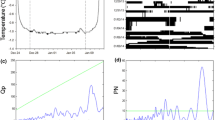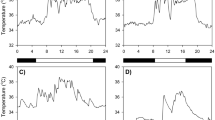Abstract
Mammalian hibernation is characterized by profound reductions in body temperature (T b) and metabolic, heart and respiratory rates. These reductions are characteristic of torpor, which is temporally confined to winter. Hibernators including ground squirrels are heterothermic in winter, cycling between multiday periods of torpor with low T b and brief periods of rewarming. In contrast, ground squirrels remain homeothermic during summer, like non-hibernating mammals. The transition between the homeothermic and heterothermic phases of the circannual rhythm of hibernation is often overlooked in hibernation studies. Here, we examined the use of torpor throughout the fall transition in laboratory-housed 13-lined ground squirrels by recording core body temperature with an implanted data logger. As is typical of laboratory-based hibernation studies, animals were kept in standard housing prior to being moved into a cold, dark room to simulate natural hibernation conditions. Significantly, the vast majority of both male and female ground squirrels expressed torpor in the fall while still housed conventionally and prior to cold exposure. The expression of torpor was not predicted by body weight or age, rather it appears to be preprogrammed in a time-dependent manner that is independent of, yet enhanced by, environmental cues. The timing and duration of these torpor bouts occurring prior to cold exposure were also remarkably sporadic. Thus, it is not possible to know with certainty which animals are torpor-naive before cold exposure in the absence of continuous measurement of body temperature. We conclude that fall animals encompass variable points in the transition between summer and winter phases of the circannual cycle of hibernation, thereby confounding studies in which they are used as non-hibernating controls. Conversely, these fall transition animals offer unique opportunities to define the molecular changes that accompany and enable hibernation.







Similar content being viewed by others
References
Andrews MT (2007) Advances in molecular biology of hibernation in mammals. Bioessays 29:431–440
Andrews MT, Russeth KP, Drewes LR, Henry PG (2009) Adaptive mechanisms regulate preferred utilization of ketones in the heart and brain of a hibernating mammal during arousal from torpor. Am J Physiol Regul Integr Comp Physiol 296:R383–R393
Arendt T, Stieler J, Strijkstra AM, Hut RA, Rudiger J, Van der Zee EA, Harkany T, Holzer M, Hartig W (2003) Reversible paired helical filament-like phosphorylation of tau is an adaptive process associated with neuronal plasticity in hibernating animals. J Neurosci 23:6972–6981
Carey HV, Andrews MT, Martin SL (2003) Mammalian hibernation: cellular and molecular responses to depressed metabolism and low temperature. Physiol Rev 83:1153–1181
Concannon P, Levac K, Rawson R, Tennant B, Bensadoun A (2001) Seasonal changes in serum leptin, food intake, and body weight in photoentrained woodchucks. Am J Physiol Regul Integr Comp Physiol 281:R951–R959
D’Alecy LG, Lundy EF, Kluger MJ, Harker CT, LeMay DR, Shlafer M (1990) Beta-hydroxybutyrate and response to hypoxia in the ground squirrel, Spermophilus tridecimlineatus. Comp Biochem Physiol B Biochem Mol Biol 96:189–193
Dave KR, DeFazio RA, Raval AP, Dashkin O, Saul I, Iceman KE, Perez-Pinzon MA, Drew KL (2009) Protein kinase C epsilon activation delays neuronal depolarization during cardiac arrest in the euthermic arctic ground squirrel. J Neurochem 110:1170–1179
Drew KL, Buck CL, Barnes BM, Christian SL, Rasley BT, Harris MB (2007) Central nervous system regulation of mammalian hibernation: implications for metabolic suppression and ischemia tolerance. J Neurochem 102:1713–1726
Epperson LE, Rose JC, Carey HV, Martin SL (2010a) Seasonal proteomic changes reveal molecular adaptations to preserve and replenish liver proteins during ground squirrel hibernation Am J Physiol Regul Integr Comp Physiol 298:R329–R340
Epperson LE, Rose JC, Russell RL, Nikrad MP, Carey HV, Martin SL (2010b) Seasonal protein changes support rapid energy production in hibernator brainstem. J Comp Physiol B 180:599–617
Fedorov VB, Goropashnaya AV, Toien O, Stewart NC, Gracey AY, Chang C, Qin S, Pertea G, Quackenbush J, Showe LC, Showe MK, Boyer BB, Barnes BM (2009) Elevated expression of protein biosynthesis genes in liver and muscle of hibernating black bears (Ursus americanus). Physiol Genomics 37:108–118
Geiser F (2004) Metabolic rate and body temperature reduction during hibernation and daily torpor. Annu Rev Physiol 66:239–274
Gur MK, Refinetti R, Gur H (2009) Daily rhythmicity and hibernation in the Anatolian ground squirrel under natural and laboratory conditions. J Comp Physiol B 179:155–164
Hampton M, Andrews MT (2007) A simple molecular mathematical model of mammalian hibernation. J Theor Biol 247:297–302
Kalia M, Deshpande SS, Ducker T, Albuquerque EX (1983) Evaluation of regeneration of nerve and reinnervation of skeletal muscle in the hibernating ground squirrel. Exp Neurol 81:407–425
Klain GJ (1976) Hepatic utilization of glutamate during the hibernation cycle. Life Sci 19:591–596
Kondo N, Sekijima T, Kondo J, Takamatsu N, Tohya K, Ohtsu T (2006) Circannual control of hibernation by HP complex in the brain. Cell 125:161–172
Lyman CP, Willis JS, Malan A, Wang LCH (1982) Hibernation and torpor in mammals and birds. Academic Press, New York
Nelson CJ, Otis JP, Martin SL, Carey HV (2009) Analysis of the hibernation cycle using LC–MS based metabolomics in ground squirrel liver. Physiol Genomics 37:43–51
Serkova NJ, Rose JC, Epperson LE, Carey HV, Martin SL (2007) Quantitative analysis of liver metabolites in three stages of the circannual hibernation cycle in 13-lined ground squirrels by NMR. Physiol Genomics 31:15–24
Shao C, Liu Y, Ruan H, Li Y, Wang H, Kohl F, Goropashnaya AV, Fedorov VB, Zeng R, Barnes BM, Yan J (2010) Shotgun proteomic analysis of hibernating arctic ground squirrels. Mol Cell Proteomics 9:313–326
Storey KB (2010) Out cold: biochemical regulation of mammalian hibernation—a mini-review. Gerontology 56:220–230
Twente JW, Twente JA (1965) Effects of core temperature upon duration of hibernation Citellus lateralis. J Appl Physiol 20:411–416
Vaughan DK, Gruber AR, Michalski ML, Seidling J, Schlink S (2006) Capture, care, and captive breeding of 13-lined ground squirrels, Spermophilus tridecemlineatus. Lab Anim NY 35:33–40
Wang LCH (1988) Mammalian hibernation: an escape from the cold. Adv Comp Environ Physiol 2:1–45
Wilz M, Heldmaier G (2000) Comparison of hibernation, estivation and daily torpor in the edible dormouse, Glis glis. J Comp Physiol [B] 170:511–521
Zar JH (1996) Biostatistical Analysis. Prentice-Hall International, London
Acknowledgments
We thank K. Grabek for helpful discussion. This work was supported in part by Hiberna, Inc, and by a grant from the National Institutes of Health, HL089049.
Author information
Authors and Affiliations
Corresponding author
Additional information
Communicated by H.V. Carey.
Rights and permissions
About this article
Cite this article
Russell, R.L., O’Neill, P.H., Epperson, L.E. et al. Extensive use of torpor in 13-lined ground squirrels in the fall prior to cold exposure. J Comp Physiol B 180, 1165–1172 (2010). https://doi.org/10.1007/s00360-010-0484-8
Received:
Revised:
Accepted:
Published:
Issue Date:
DOI: https://doi.org/10.1007/s00360-010-0484-8




